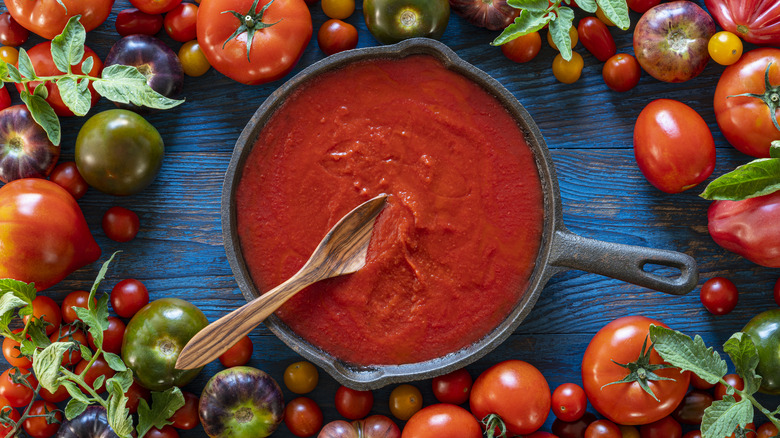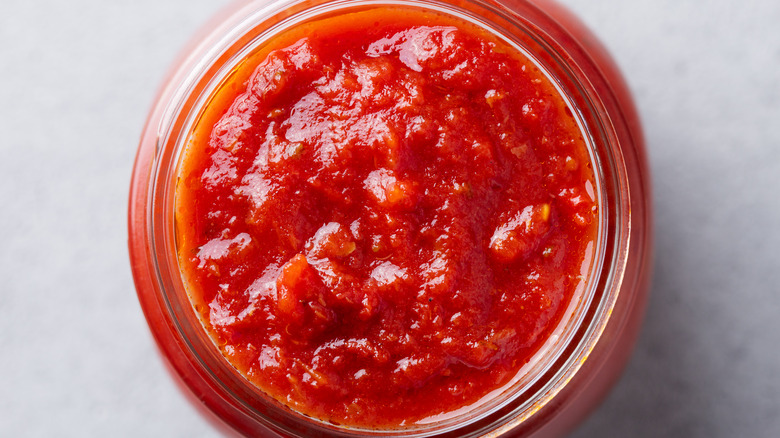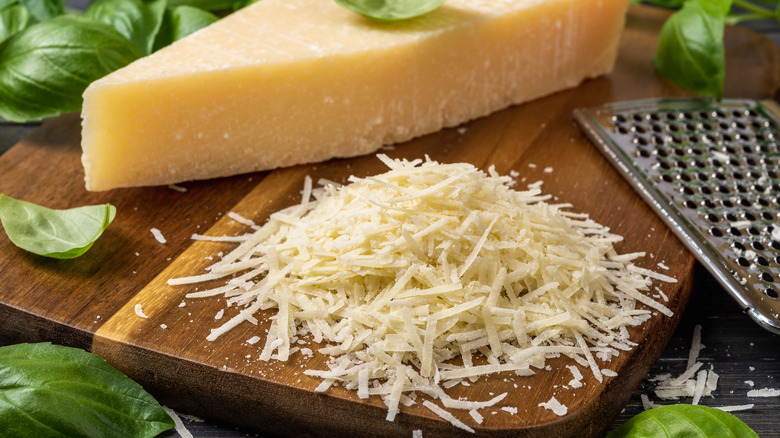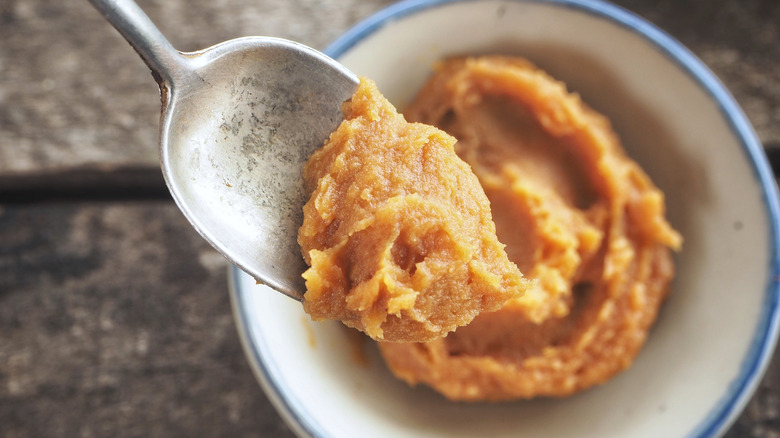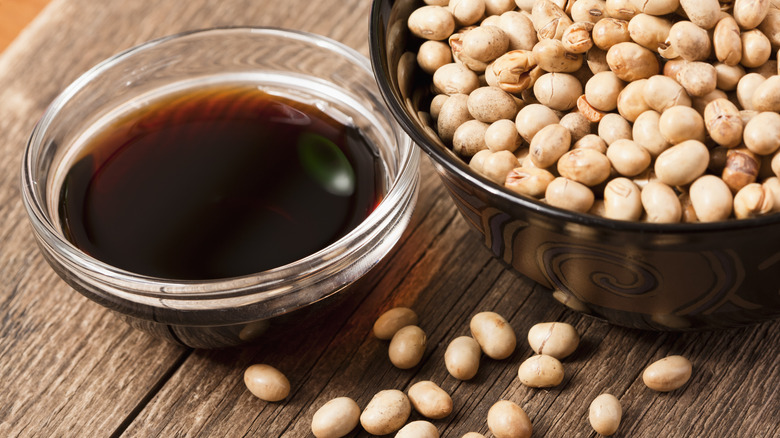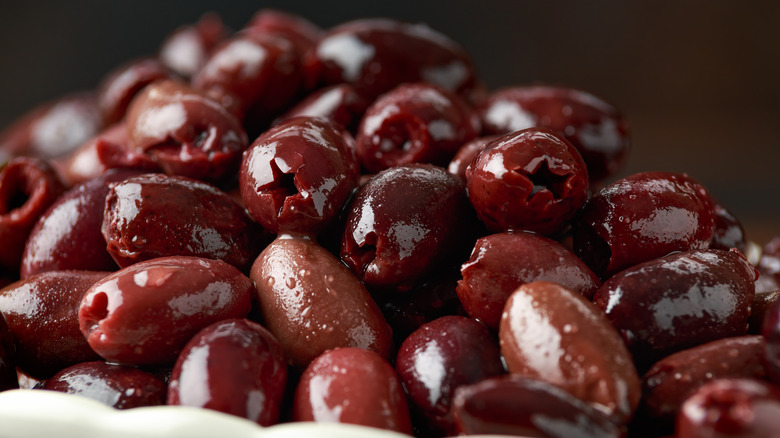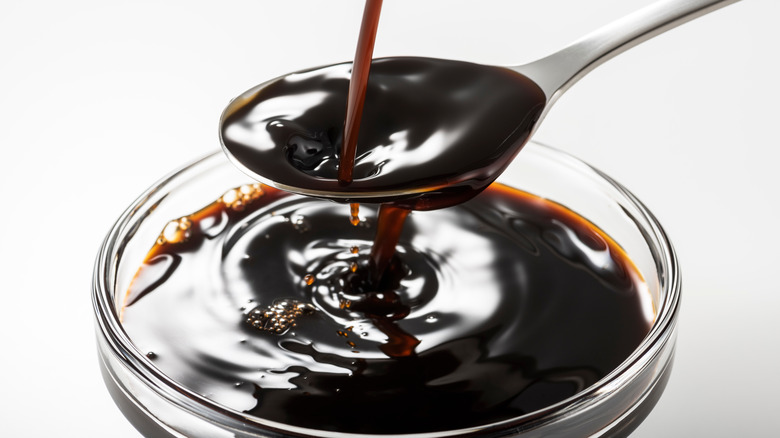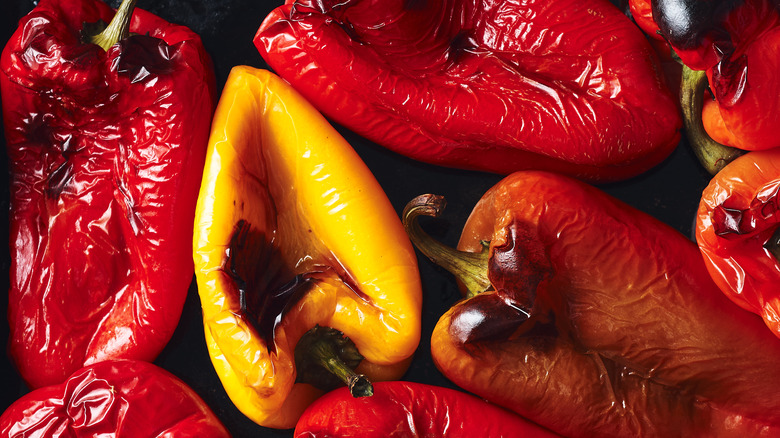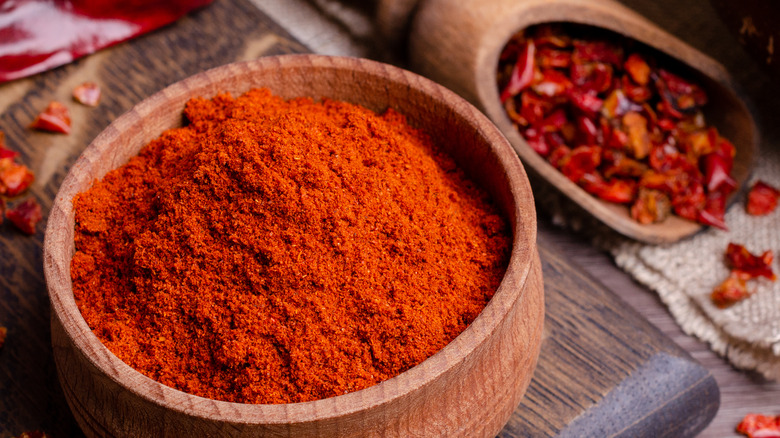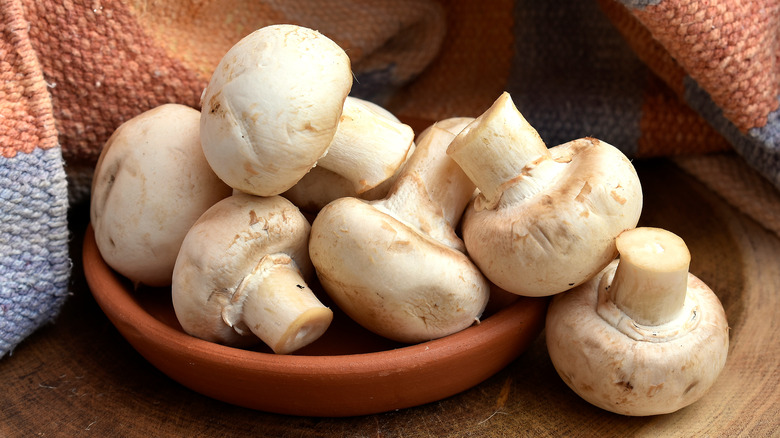The 11 Best Umami Boosters For Store-Bought Tomato Sauce
When it comes to delicious tastes, few things compare to the beauty of homemade pasta sauce — or "gravy" as most Nonnas call it. You get the natural sweetness and tang of fresh tomatoes; the pungent bite of onions; the sharp, nuttiness of garlic; and the rich, peppery smoothness of extra virgin olive oil. Throw in some fresh basil and oregano and a few fiery, pepper flakes and you've got all the essential flavors for an incredible meal.
As these ingredients sit for hours on the stove, they transform in amazing ways. That slow cooking helps the flavors to concentrate, intensify, and meld together. Essential oils are released from herbs, and sugars in the sauce caramelize leading to an end result that is not just rich and complex, it's also packed with the flavor of umami.
As you may already know, umami is our unofficial fifth food flavor (joining sweet, sour, salty, and bitter). It was discovered by a Japanese scientist in 1907. Based on the word "umai" — Japanese for "tasty" — the term is now used to describe the savory quality of foods like mushrooms, seafood, cheese, and aged or cured meats. It means a flavor that is pleasing and rich and that lingers on the tongue. It's meaty or brothy, balanced, and mouthwatering, with a hearty aftertaste. And, it's the essence of homemade pasta sauce.
The problem with store-bought sauces
As much as we'd all love to be like our grandmothers and make amazing homemade pasta sauces from scratch, the modern world doesn't always allow for that to happen. There's work and errands and family to attend to — kids need to be shuttled around, dogs need to be walked, and houses cleaned. Spending the bulk of a day carefully babysitting a vat of tomato sauce is a luxury many of us simply don't have time for.
That's why the average grocery store is filled with dozens of varieties of prepared pasta sauce. You've got meat and cheese sauces, four cheese blends, garden veggies, and lots of good old-fashioned marinara. And for the most part, they're pretty good. Some need more salt. Some are way too sweet. But, the one thing they're all missing is that incredible hint of homemade umami flavor. They just taste like sauce from a jar.
But, on the bright side, these jar sauces can be an incredible blank canvas for you to make your own by throwing in a bit of this or a dash of that. Most importantly, though, you can imbue these sauces with the wonderful flavor of umami. Here are 11 quick and easy ways to work that transformative magic, giving your favorite store-bought sauce the delicious umami goodness of a sauce that's been cooking for days.
Parmesan cheese
Ever wonder why Parmesan cheese is such a perfect partner for tomato-based sauces? It's because it's packed with umami flavor! When cheeses like Parmesan, Gouda, or Pecorino Romano are left to age and mature, proteins within the cheese break down, releasing an amino acid that gives them an umami-rich punch. Italian chefs realized this hundreds of years ago and began pairing cheese and pasta sauce and we've been doing it ever since!
Increasing the umami flavor of a bottled pasta sauce can be as simple as just shaking in a hefty dose of grated Parmesan from a can while the sauce is heating. But, for an even more powerful umami kick, freshly grate the cheese instead. Measure out around ½ cup of Parmesan and stir it into your sauce while it heats. Or, take the rind from the Parmesan and add it to your simmering sauce to further infuse it with umami goodness. (Just be sure to remove before serving!)
Don't limit yourself to just Parmesan either. As we mentioned, all aged cheeses contain a hefty dose of umami flavor — and each can add a wonderful, unique twist to standard prepared pasta sauce. Try grating and stirring in some Gorgonzola or Camembert. Or add the nutty bite of Asiago. Even some blue cheese crumbles can work wonders — just dump a handful into your favorite sauce, stir in some fresh spinach and serve over classic spaghetti noodles. Easy and delicious!
Fish sauce
Fish sauce may not seem like an ingredient you would use on pasta night, but this popular Southeast Asian condiment is an ideal way to add umami flavor to prepared pasta sauce. A staple in Thai, Vietnamese, and Filipino cooking, fish sauce is made from small, oily fish like anchovies or sardines that are coated with salt and then allowed to ferment for months or even years at a time. During this fermentation process, the fish sauce develops a rich umami flavor, in much the same way aged cheese does when it is left to sit and ripen.
If you're new to using fish sauce, it's important to note that a little goes a long way! To enhance the umami flavor of a prepared pasta sauce, start by adding a few drops of fish sauce to your pot and then taste the mixture. If you like it, add more — you could go up to one or two teaspoons depending on just how much umami flavor you want to create. Fish sauce is an especially great addition to seafood pasta dishes, like anchovy-filled spaghetti puttanesca or calamari arrabbiata.
Miso paste
Miso paste is another Asian cooking staple that you may not think to add to pasta sauce, but that's ideal for giving prepared sauces a burst of umami richness. This traditional Japanese seasoning is made from fermented soybeans, rice or barley, and salt. It's a rich, savory paste loaded with umami flavor. Miso soup is one of the most well-known uses for this paste, but it is also commonly added to marinades, glazes, sauces, and salad dressings as well — and the umami truly shines in each of these preparations.
The most effective way to add miso to a bottled pasta sauce is to simply stir in a tablespoon of the paste as the sauce heats on the stove. For a more subtle miso flavor, you can also add miso paste to the water you cook your pasta in. The umami flavor of the miso will infuse into the pasta as it softens, and will then help to flavor your sauce when you combine the two. Although miso will work in almost all tomato-based pasta dishes, it's especially great in a puttanesca, Bolognese, or even a vodka sauce where that umami richness can really stand out as the star of your meal.
Soy sauce
By now you're likely noticing that a number of different popular Asian foods have umami-rich flavors that work well in pasta sauce. And, that's especially true for the king of Asian condiments and one of the most widely used ingredients in all sorts of Asian foods. We're talking, of course, about soy sauce – the dark rich elixir that's made from soybeans, wheat, water, and salt. As soy sauce ages and ferments, proteins in the soybeans and wheat break down, again creating those wonderful umami-flavored amino acids that form the backbone of Asian cooking.
Adding soy sauce to pasta sauce is pretty straightforward: Just pour some in. Use anywhere from a teaspoon to a tablespoon depending on just how much umami flavor you want. If you cook pasta frequently and really want to add umami flavor to your sauce in layers, you can also create a batch of soy and tomato paste ice cubes that you prepare and freeze in advance and then just add to your sauce as it heats. To make the cubes, combine some soy sauce and tomato paste in a small saucepan and heat until smooth and well combined. Add garlic powder or other herbs if you like — whatever you typically use to flavor your pasta sauce. Portion the final sauce mixture into an ice cube tray and freeze. Then use as needed!
Chopped olives
Similar to Parmesan cheese, olives are another perfect partner for tomato-based pasta sauces. And like Parmesan cheese, they're also naturally packed with robust, savory umami flavor. In this case, the umami in olives comes from the ripening and curing process. The riper and more aged the olives are, the greater their umami richness. So, while green olives tend to be relatively light in umami flavor, Kalamata olives, Gaeta olives, and black olives are filled with the flavor.
To increase the umami quotient in a jar of bottled pasta sauce — and imbue it with salty olive goodness at the same time — try adding anywhere from ½ cup to a full cup of diced olives to your sauce as it heats. If you have a favorite tapenade, you could alternately add a spoonful or two of it to your pasta sauce as well. In addition to the richness of the olives, a premade tapenade can help infuse your sauce with flavors like capers, garlic, olive oil, or lemon juice — all of which will make it even more flavorful and dynamic.
For the greatest olive and umami flavor, you might also consider whipping up a quick olive ragù and stirring that into your pasta sauce while it simmers. To make the ragù, just sauté some olives, mushrooms, onions, garlic, and herbs together until tender and caramelized. Then pour the mixture into your sauce, stir, and let it heat until warm.
Worcestershire sauce
Worcestershire sauce may be a quirky condiment with a crazy name none of us can pronounce. But, it's also a great way to add umami flavor to a wide variety of foods, including prepared pasta sauces. Created from a blend of vinegar, molasses, anchovies, tamarind, garlic, onions, and spices, it's another fermented sauce created specifically for the umami-rich flavors it can impart to foods. As legend has it, two pharmacists (John Wheeley Lea and William Henry Perrins) living in Worcester, England created the sauce in 1837 as part of an attempt to mimic a fish sauce Lord Sandys had sampled — and loved — while governor of Bengal. (The sauce they originally created still bears their name to this day!)
To flavor pasta sauce with the umami notes found in Worcestershire sauce, just add a few dashes of the sauce directly into your pot as your sauce heats. If you like things spicy, toss in some red chili flakes as well — their heat meshes perfectly with the tart umami tang found in Worcestershire sauce. The sauce also goes especially well with meat, making Worcestershire sauce an ideal addition to a Bolognese or pasta sauce you will be using in other meat-based dishes like a pizza or lasagna.
Add the char of roasted bell peppers
Letting food ferment or age isn't the only way you can give it a kick of umami richness. Grilling and charring food over an open flame can also intensify its rich, savory umami flavor. That's why grilled steaks or pork chops often taste even more delicious and satisfying than if they've been cooked in the oven or over lower heat — they gain the smoke and char of the grill, as well as that more intense umami-forward flavor we all love.
One simple way to add the umami flavor of the grill to pasta sauce is with roasted bell peppers. When these peppers cook over a flame, the sugars inside them caramelize, revealing a deep robust umami flavor. You can flame roast bell peppers on an open grill outdoors or simply toast a clean, halved bell pepper directly over the burner on your gas stovetop. Whichever method you take, let the peppers cook until their skin starts to blister and blacken. The greater their char, the more umami flavor they'll contain.
Let your roasted bell peppers cool until they can be handled, then dice and stir directly into your simmering pasta sauce. For an incredible umami-packed, plant-based meal without any meat, pair your roasted bell pepper sauce with eggplants for an incredible eggplant Parmesan or eggplant and mushroom Bolognese.
Shake in some smoked paprika
If you don't have the time or patience to roast bell peppers for your pasta sauce, you can also consider adding the next best thing in their place: smoked paprika. This pungent, flavorful spice is actually made from dried and smoked red peppers that have been ground to a fine powder. That drying and smoking process gives smoked paprika a powerful umami kick that's perfect for adding flavor and depth to store-bought pasta sauce.
The best way to infuse pasta sauce with umami flavor from paprika is to simply stir around 1 teaspoon of the spice directly into the sauce as it simmers. Taste the sauce and if you want, add more from there. In addition to smoked paprika, you can also try adding fennel seed, garlic powder, onion powder, dried basil, or dried ground ginger to your pasta sauce. Each of these spices also contains some umami flavor and can help to give a pre-made sauce a fresher, more unique, and interesting flavor profile that's perfect for enjoying over pasta ... and impressing friends and family at the same time.
Roasted garlic
Like roasted bell peppers, roasted garlic is another excellent way to add umami flavor to prepared pasta sauces. When garlic is cooked at high heat — either on a grill or in the oven — the natural sugars in the garlic caramelize and react with the amino acids, creating deep, flavorful umami notes. If that weren't reason enough to throw some garlic on to roast right now, consider that cooking garlic also helps to mellow its sharp and pungent flavor, transforming it into a sweeter, more caramelized taste.
To quickly and easily roast garlic, just preheat your oven to 400 degrees Fahrenheit. Grab a full bulb of garlic — unpeeled and with all the cloves intact — and slice the top off. Drizzle on some olive oil, wrap everything in aluminum foil, and let roast for about 40 minutes or until the cloves are soft and golden brown. Once roasted, let the garlic cool until you can handle it, and then carefully squeeze the soft cloves out of the bulb. they should be easily spreadable — no need to mince — so just add them directly to your sauce. Start with a few cloves and keep adding until you reach your desired level of umami richness.
Red wine
Like its aged and fermented cousins in the cheese and condiments aisles, red wine gets its umami punch when table grapes are squeezed, bottled, and left to turn into a wonderful glass of vino. And, that means wine is also one more incredible tasty way to add umami flavor to store-bought pasta sauces. If you're in a hurry, simply pour between ¼ cup and ½ cup of your favorite red wine — or a good cooking wine if you prefer to drink the good stuff — into a pot of pasta sauce as it simmers. Depending on how much wine you use, you'll need to cook it for varying times to boil off all the alcohol — needing around 2 hours if (for example) you've used 1 cup of Burgundy
Alternatively, you can also use red wine to deglaze the pan after sautéing onions or garlic to add to your pasta sauce. Just pour about ½ cup of wine into the hot pan, scrape the bottom of the pan with a spatula to release the browned bits and then let everything reduce a bit before adding to your sauce.
For an alcohol-free variation, do the same thing with balsamic vinegar. If adding balsamic vinegar directly to your sauce, use a smaller amount — about 1 to 2 tablespoons. If you're deglazing, you can add about ¼ to ½ cup of balsamic vinegar to your hot pan and then deglaze and reduce in the same way you would if you were using wine.
Fresh or dried mushrooms
Last, but certainly not least, if you really want to add umami flavor to a prepared pasta sauce, don't forget about the number one source of umami flavor around – mushrooms! Unlike foods that gain their umami flavor while fermenting or aging, mushrooms inherit their umami flavor naturally. Those tasty amino acids that help us to sense umami on our tongue when we eat are a naturally occurring part of their biological makeup.
You can get loads of umami flavor in fresh mushrooms, and that flavor becomes even richer and more abundant when the mushrooms are cooked or dried. While all mushrooms are packed with umami flavor, those that people often describe as "meaty" tend to have the richest levels. Porcini, shiitake, maitake (or "Hen of the Woods"), morel, and Portobello mushrooms are all particularly good sources of umami flavor.
Add fresh, raw, or dried mushrooms directly to pasta sauce as it heats if you intend to let the sauce simmer long enough for them to cook or rehydrate. Alternately, you can also sauté as few or as many fresh mushrooms as you would like until soft and caramelized, and then stir those cooked mushrooms into your pasta sauce. Remember that mushrooms shrink as they cook, losing about half their volume. So, if you want to add a cup of cooked mushrooms to your sauce, you need to sauté two to three times that amount of fresh mushrooms. Bon appetit!

